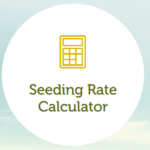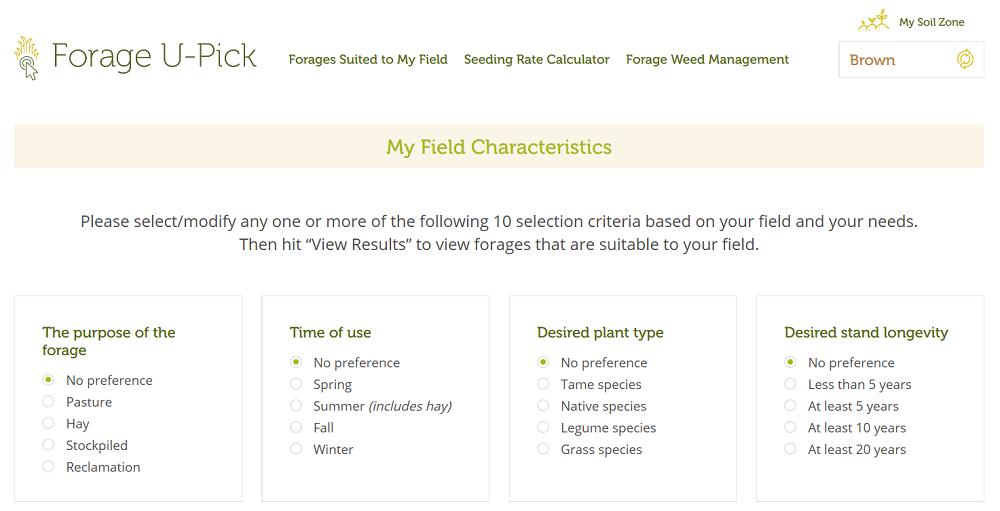Forage U-Pick: A new interactive forage species selection tool for Western Canada
Remarque : cette page web n’est actuellement disponible qu’en anglais.

The Forage U-Pick project was supported by over 13 different organizations through contributions of time and expertise. Funding was provided by the Beef Cattle Research Council, Alberta Beef, Forage and Grazing Centre, Saskatchewan Forage Council, and the Government of British Columbia and Government of Canada through the Canadian Agricultural Partnership.
Forages for hay and pasture are essential for beef production. Ensuring forage species are well-matched to growing conditions improves establishment rates, yield, vigour and quality. This can reduce costs, improve utilization and number of grazing days, and increase profitability. Using accurate production information can produce positive impacts on beef and forage productivity, sustainability, and competitiveness.
Forage U-Pick is a tool designed to provide users with information for forage selection, forage seeding rates, and weed management.
While every effort has been made to compile accurate and useful information, this tool should be considered a starting point for decision-making. When selecting a forage or forage mix, the Forage U-Pick tool should be used in conjunction with additional feedback from local professionals, other available technical resources, and the latest forage research.
Increasing forage productivity by just 0.1 tons/acre on 160 acres, through proper selection, seeding rate or weed control, produces 16 tons more forage per quarter section per year.

What can Forage U-Pick do for you?
Forage U-Pick can help you find the forage species that are best-suited to your field, and your end use.
Forages Suited to My Field allows you to choose your province, your soil zone or a regional zone and then starts with a list of forage species that are suited to your selected zone.
Researchers have been documenting forages suitability to specific zones, under different climatic conditions, for 60 years. That list is updated continually, and all those updates are included in Forage U-Pick!
The Forage U-Pick tool allows you to select specific criteria to narrow down the options of forages best-suited to your situation. The most important criteria will be “in my field” or “how I want to use the forage.” There are 10 criteria to chose from, but selecting your top two or three priorities will give you the most species results and options. If you want to see all the forage species suited to your zone, simply leave all as “no preference” before selecting view results.
More information about each forage species can be found when you click on each individual species picture and name. Detailed species information was provided from the BC Rangeland Seeding Manual in combination with other provincial resources.
Single fields often have combinations of many different characteristics such as saline and non-saline, or different flooding durations. For these areas of variable topography or field characteristics, consider running different scenarios for different areas of your field. The seeding rate calculator is used once you have selected the forages you want to seed. It will ensure that you put the right amount of seed in the ground to have the best possible chance for a good stand.
My Field Characteristics
Example: If you enter Moderate Salinity, U-Pick will only return forages that are suited to moderate salinity. Those not suitable will be shaded out.

Why is a calculator so important? Say you’d like 20% hybrid bromegrass and 20% tall fescue in your field when the stand establishes. Even though you want 20% of each grass, seed size and the number of seeds per pound will vary, so you won’t seed both of those forages at the same rate.
Another important factor to consider is the Pure Live Seed (PLS) of the seed lot you are purchasing. Pure Live Seed is the per cent germination multiplied by the per cent purity. If a seed lot has lower germination, more seeds must be planted in order to ensure that the right number of seedlings will begin to grow. Forage U-Pick starts with default minimums, based on the Canada Seeds Act, where possible. It is best to work with your seed supplier to determine accurate germination and purity values for the seed you have purchased.

Forage U-Pick has also provided guidance for scenarios where an increased seeding rate will help set the stage for a successful forage stand. Share the table you create at the bottom of the calculator with your seed supplier. Economic success in forages can increase with proper weed control. This section provides great resources for weed identification, provincial information and overviews of common weeds in forages for each of the zones in western Canada. The presence of weeds during establishment, and those in established stands, often vary greatly. Both can have an economic impact on forage stands.
The goal of the Forage U-Pick project is to help Western Canadian producers be successful by selecting the best forages for individual conditions, and ensuring that seeding rates are adequate for healthy, profitable stands.
Click here to subscribe to the BCRC Blog and receive email notifications when new content is posted.
The sharing or reprinting of BCRC Blog articles is welcome and encouraged. Please provide acknowledgement to the Beef Cattle Research Council, list the website address, www.BeefResearch.ca, and let us know you chose to share the article by emailing us at info@beefresearch.ca.
We welcome your questions, comments and suggestions. Contact us directly or generate public discussion by posting your thoughts below.
